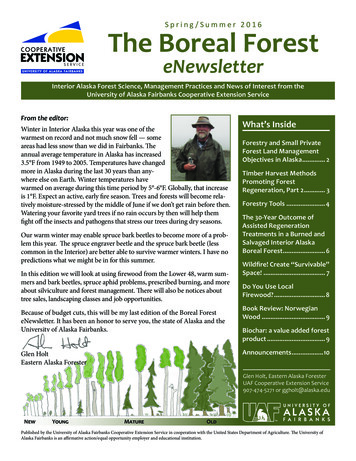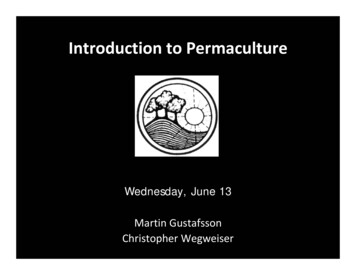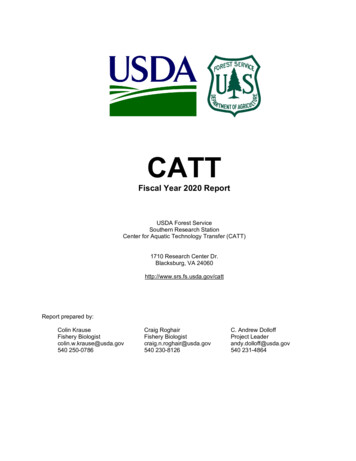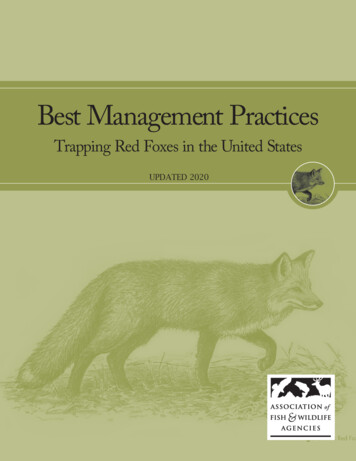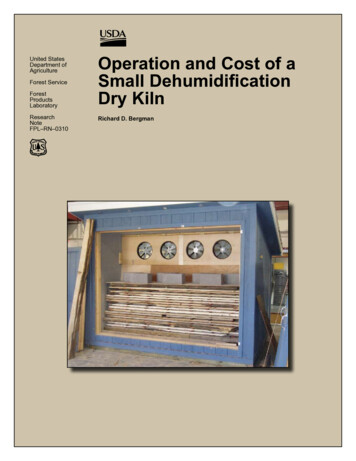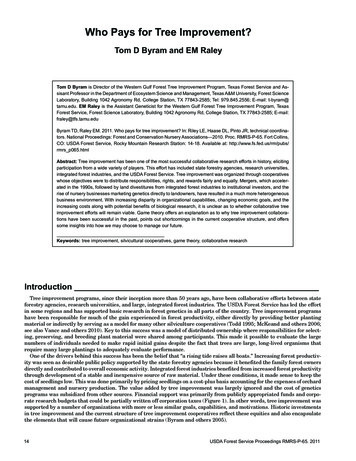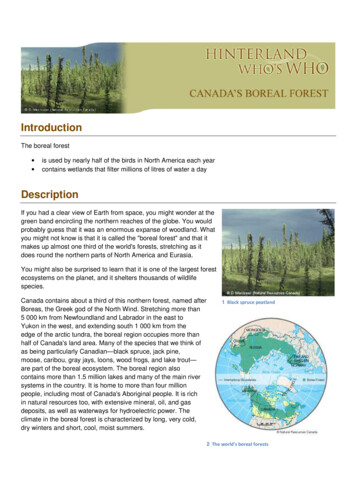
Transcription
IntroductionThe boreal forest is used by nearly half of the birds in North America each yearcontains wetlands that filter millions of litres of water a dayDescriptionIf you had a clear view of Earth from space, you might wonder at thegreen band encircling the northern reaches of the globe. You wouldprobably guess that it was an enormous expanse of woodland. Whatyou might not know is that it is called the "boreal forest" and that itmakes up almost one third of the world's forests, stretching as itdoes round the northern parts of North America and Eurasia.You might also be surprised to learn that it is one of the largest forestecosystems on the planet, and it shelters thousands of wildlifespecies.Canada contains about a third of this northern forest, named afterBoreas, the Greek god of the North Wind. Stretching more than5 000 km from Newfoundland and Labrador in the east toYukon in the west, and extending south 1 000 km from theedge of the arctic tundra, the boreal region occupies more thanhalf of Canada's land area. Many of the species that we think ofas being particularly Canadian—black spruce, jack pine,moose, caribou, gray jays, loons, wood frogs, and lake trout—are part of the boreal ecosystem. The boreal region alsocontains more than 1.5 million lakes and many of the main riversystems in the country. It is home to more than four millionpeople, including most of Canada's Aboriginal people. It is richin natural resources too, with extensive mineral, oil, and gasdeposits, as well as waterways for hydroelectric power. Theclimate in the boreal forest is characterized by long, very cold,dry winters and short, cool, moist summers.1 Black spruce peatland2 The world's boreal forests
Canada’s Boreal Forest3 The boreal forest in CanadaBoreal SpeciesPlantsThe boreal forest is teeming with life. To describe it, let's begin with the trees that make up the forest canopy.There are about 20 species of them, and most are coniferous, which means that they produce their seeds incones. Spruce, fir, pine, and tamarack are the main species found in the Canadian boreal forest. Except fortamarack, which drops its needles every fall, they remain green all year. Broad-leaf deciduous trees, such astrembling aspen, balsam poplar, and birch, are also widely distributed across the boreal forest.Coniferous trees are particularly well suited to the harsh boreal climate. Their conical shapes reduce snowbuildup on branches in winter, so that they do not break under the snow load. Their narrow needles have thickwaxy coatings which protect the trees from drying winds. These needles have tiny pores which allow gases tomove in and out of the trees: this is how they “breathe.” These pores are sunken into the waxy layer, to helpreduce water loss.In order to grow, plants need to photosynthesize—a process that converts energy in sunlight into food for theplant. To thrive in the short boreal summers, conifers have adaptations to help maximize photosynthesis. For2
Canada’s Boreal Forestexample, because their foliage remains green year-round, conifer treescan photosynthesize in the spring without having to grow leaves first. Infact, they can even photosynthesize on warmer days in the winter.The deciduous trees, such as aspen, are also adapted to the borealconditions. They grow leaves to photosynthesize in the summer, and thenshed them before it gets cold in winter. In this way, the trees are lessdamaged by heavy snowfalls. Before the leaves fall, the trees take backsome of the nutrients from the leaves, to use in the next year’s growth.Aspens also have chlorophyll (green cells that are needed forphotosynthesis) in their bark, so that they can make some food in winteron warmer days.All of these tree species support a range of birds, mammals, and otherwildlife. They also store large amounts of carbon and produce a great dealof oxygen, so much that in the spring and summer in the northernhemisphere, when the boreal trees are growing most vigorously,worldwide levels of carbon dioxide fall and global levels of oxygen rise.While trees are the dominant plant species, many other plants thrive in the 4 Black spruce and feathermossboreal forest, including shrubs, mosses, and lichens. Some shrubs, suchas willow, alder, blueberry, red-osier dogwood, and honeysuckle, produce bright-coloured or conspicuousberries that attract fruit-eating birds and provide food for mammals fromsmall rodents to bears.Under coniferous trees, mosses grow so thickly that they form a completecarpet on the soil's surface, keeping the soil moist and cool andpreventing many other types of plants from growing. Open areas arecarpeted with yellow, green, and light grey lichens. Some lichens grow onwood too. Lichens are combinations of fungi and algae that benefit eachother: the underlying fungus provides structural support for the lichen,while the algal layer on top has chlorophyll which provides food for thelichen through photosynthesis. Lichens remain intact all year long, andare an important food source in winter for species such as caribou.Wetlands—bogs, fens, and marshes—occupy 30 percent of Canada'sboreal forest. Boreal wetlands are often referred to as muskegs orpeatlands. These peatlands are usually on poorly drained, flat terrain.Plant material decomposes slowly in the cool, wet soil conditions, forming 5 Aspena blanket of material that is often several metres thick. Sphagnum andother mosses, sedges, and low shrubs make up the peatland vegetation. Treed peatlands, composed mostly oftamarack and black spruce, are also widespread. Some mosses, such as sphagnum, are especially importantin peatlands where they can create acidic environments.3
Canada’s Boreal ForestThese wetlands are invaluable: they filter millions of litres of water every day, and they provide breeding,moulting, and staging (resting and feeding) habitat for more than 13 million ducks—about 40 percent of theNorth American duck population.BirdsNearly half of the birds in North America rely on the boreal forest at sometime during the year. It is estimated that at least 3 billion landbirds, waterbirds, and shorebirds breed in the boreal forest each year, representingmore than 300 species. Another 300 million birds, including severalspecies of shorebirds, swans, and geese, breed farther north and travelthrough the boreal forest during migration.Many of the birds that we see in our communities have bred in the borealforest or passed through it travelling north or south, and many of theseare the singers of the forests—small birds such as warblers, vireos,thrushes, kinglets, grosbeaks, sparrows, and flycatchers—which arehard to see but wonderful to hear. Ducks, loons, grebes, rails, gulls,kingfishers, and cranes depend on Canada's boreal waters for nestingand for food.6 Cape May WarblerOther bird species, such as woodpeckers, finches, nuthatches,chickadees, owls, grouse, and ravens, can live in the boreal forest year-round, having adapted to the climate.Black-capped chickadees, for example, have black and white feather patterns that are designed to absorb heatand provide the best insulation when they are sleeping. They can also sleep in holes in the snow which act liketiny igloos to keep them warm. In winter, Great Gray Owls use their extremely sensitive ears and silent flight tolocate and capture small mammals under the snow, and Ruffed Grouse grow scales on the sides of their toesthat turn their feet into snowshoes.MammalsThe boreal forest shelters more than 85 species of mammals,including some of the largest and most majestic—wood bison,elk, moose, woodland caribou, grizzly and black bears, andwolves—and smaller species, such as beavers, snowshoehares, Canada lynx, red squirrels, lemmings, and voles.Of these, the snowshoe hare is the most ecologicallyimportant. It is a food source for many of the boreal forest'spredators (both mammals and birds) and feeds on the forest'svarious plants and shrubs, linking all of these species in a tightfood web.7 Beaver damsLike other species, many mammal species have adapted toconditions in their boreal home. For example, the snowshoe hare turns from brown-grey in the summer towhite in the winter, so that it always blends with its surroundings. Moose, wood bison, and other large4
Canada’s Boreal Forestmammals have a low surface area-to-volume ratio, which minimizes the amount of body heat they lose inwinter.The beaver is one of the most important animals in the boreal forest. Using its ever-growing front teeth, it fellstrees and eats the leaves, twigs, and bark, using the wood to build dams and lodges. Beaver dams flood partsof the forest, creating ponds and wetlands that are used by fish, waterfowl, and amphibians.Reptiles and amphibiansThe boreal forest is a challenging home for reptiles and amphibians, which depend on environmentalconditions to regulate their body temperatures. Spring and summer temperatures likely limit how far northmany species are found, since temperatures must be high enough for eggs to hatch and young to grow. Insummer, reptiles and amphibians choose appropriate habitat and bask in the sun to reach body temperaturesthat allow them to hunt effectively and digest prey. In winter, most amphibians and reptiles that hibernate onland seek out sites underground where temperatures consistently remain above freezing, although wood frogsand chorus frogs simply burrow in the leaf litter and depend on chemicals to make them freeze-tolerant; duringhibernation, more than 40 percent of their body fluids can consist of ice. Other frogs and turtles hibernate at thebottom of ponds and lakes.InsectsInsects are critical components of boreal food webs and play important ecological roles as pollinators anddecomposers, yet as a group, they are among the most poorly understood organisms in the boreal region.Except for relatively few species, mainly those considered "pests" because of the economic losses they causeby damaging or killing trees, or highly conspicuous groups such as butterflies, little more than the names andgeneral habitat preferences is known.It is estimated that 32 000 insect species inhabit Canada's boreal forest, although about one third of thesespecies have yet to be described. Among the known species, several are particularly well adapted to theirhabitat. For example, black fire beetles have infrared sensing organs on their bodies that allow them to trackthe heat of forest fires as they search for freshly burned trees on which to lay their eggs. Other species, like thewhite-spotted sawyer beetle, use their long antennae to sense chemicals in smoke and charcoal to achieve thesame goal. Like many other insect species, in addition to starting the decomposition of fire-killed trees, thesetwo beetle species are an important part of the diet of several bird species commonly found in burned forests.FishCanada's boreal forest is home to about 130 species of fish. Most fish species in the boreal region are small,like minnows and stickleback. Larger species, including walleye, northern pike, lake trout, Arctic grayling,yellow perch, brook trout, whitefish, and burbot, are some of the most common game fish.Fish living in the boreal forest are a hardy bunch, as they have to contend with long winter months and coldtemperatures. Numerous fish species also migrate between different areas of rivers and lakes at different timesof the year. For instance, many populations of bull trout live in different areas of the river during the winter,summer, and fall. Perhaps the largest migrations are completed by chum salmon and chinook salmon in themost northwestern portion of the boreal forest. These species are born in small streams, but migrate to the5
Canada’s Boreal Forestocean, where they grow and mature, before migrating back into rivers to reproduce and die. The majority ofthem return to the same area where they were hatched, and migrations of several hundred kilometres arecommon.Some fish, like northern pike and walleye, feed on other fish species; species such as lake trout, white sucker,lake sturgeon, and lake whitefish eat aquatic insects and other invertebrates; still others, such as yellow perch,cisco, and many minnow species, feed on tiny zooplankton in the water. In turn, fish are food for eagles,osprey, herons, loons, mergansers, bears, and otters.BenefitsThe boreal region not only supports the species that live within it; it also provides benefits that extend beyondits borders. The forest's extensive wetlands lessen the effects of floods and droughts by storing andmoderating the flow of water between upland areas and lowland regions. Its wetlands also act as water filtersby removing impurities from the water that flows through them.The boreal forest's trees and other vegetation help to control erosion, improve the cycling of nutrients, andpromote the formation of soil. Sometimes natural disturbances, such as forest fires, contribute to plant growth.Fires release nutrients that were tied up in leaves, logs, and needles on the forest floor, which can aid in thevigorous regeneration of vegetation following fire. The forest also helps to regulate the earth's climate bystoring carbon in peat deposits, soils, lake sediments, and trees. This prevents atmospheric carbon from beingreleased as carbon dioxide and methane, two gases linked to climate change.As one of the few remaining relatively intact ecosystems on our planet, the boreal forest helps to preservebiodiversity, or the variety of life on Earth. Every living thing plays an essential role in maintaining a balance inEarth's natural processes. That's why biodiversity is so important. And that is why the boreal forest is importanttoo. The Canadian boreal forest is home to about two thirds of Canada's 140 000 species of plants, animals,and micro-organisms.Economic activity in the boreal forest sparks other benefits. It brings products to people around the world andsupports the people who live and work in the boreal region. Much of the world's forestry, mining, oil and gasproduction, hydroelectric generation, tourism, and harvesting of natural products occur in the boreal forest.About 14 percent of Canadians living in hundreds of communities located in the boreal region rely on theseindustries. Others make their livings on land at the southern edge of the boreal forest that has been convertedinto farmland. The boreal forest is home for about 80 percent of Canada's Aboriginal peoples, whose richheritage is strongly linked to the forest.Distrubances and ThreatsUnfortunately, there are negative aspects to development in the boreal forest. The main consequences arehabitat loss and fragmentation. These occur when land is cleared for farmland or flooded to make reservoirsfor hydroelectric generating stations or when seismic lines, pipeline rights-of-way, forestry roads, and minesites are cut into the forest. These activities in some cases weaken its natural systems and disturb wildlifespecies that depend on large, intact areas or require a specific habitat to survive. These impacts or changes to6
Canada’s Boreal Forestboreal ecosystems, along with pollution from some of these industries and the diversion of water flowsometimes caused by hydroelectric and mining developments, can have serious consequences for wildlife.While the boreal forest harbours few species at risk, some species are being affected by human disturbances.The most well-known species at risk found in the boreal region are some populations of woodland caribou, thewood bison, the Peregrine Falcon, the Yellow Rail, and the Whooping Crane. Maintaining boreal habitat inprotected areas has helped in the slow recovery of the wood bison and the Whooping Crane, both of whichalmost disappeared in the first half of the twentieth century.Conversion to agricultural land modifies or destroys wildlife habitat and may greatly change the amount ofcarbon that can be held in the ecosystem. Forests hold between 20 and 100 times more carbon than doagricultural crops, and they keep the carbon for longer periods.Another threat is climate change. Global increases in temperatures could bring more frequent and severedisturbances from fire and insects, for example, changes in the quantity and quality of water, and a gradualmigration northward of the forest itself. In western Canada, many of the species found in boreal lakes are neartheir thermal limits in normal conditions; a few degrees of warming could cause them to decline or disappear.Climate change is also likely to decrease biodiversity by filtering out species that do not move or spread easilyand by favouring less diverse and more aggressive, invasive, species.The boreal forest is strongly influenced by natural disturbances, such as wildfires, insects, and disease, as wellas human ones. Some of these disturbances can be positive. For example, many species are adapted to thriveafter fire in the boreal region. Pine trees release seeds when a fire's heat opens their cones, and species suchas fireweed and aspen regenerate right after fire, often from roots and shoots that survive in the soil.ActionMany people are taking steps to help the boreal forest remain healthy. Governments are examining thecombined effects of development pressures and are trying to find ways to reduce the impacts. Environmentalorganizations are working to raise awareness about the boreal forest and conducting programs to helpmaintain the forest’s health. Industry is making efforts as well. The forest sector is reducing the impact offorestry on boreal water resources and is identifying areas critical for biodiversity. Although overall explorationactivity is increasing, some oil and gas companies are working to decrease their impact by reducing the size ofseismic disturbance when they look for oil and gas, and the electricity industry is working to maintain healthypopulations of fish and wildlife during the design, operation, and maintenance of facilities. Finally, individualsare getting informed about the boreal forest and are taking action, like reducing, reusing, and recycling paperproducts, and adopting alternative energy sources.While all of these actions will help reduce the impacts on the boreal forest, a big challenge is managing theboreal region in a sustainable manner. To do this, scientists are working to increase our knowledge, trying tounderstand how boreal ecosystems function, how human activities affect the forests, and how we can makebetter decisions about those activities. Greater scientific understanding, along with a wealth of traditionalknowledge, can be used to sustain our magnificent boreal forest now and for generations to come.7
Canada’s Boreal ForestResourcesOnline resourcesBird Studies Canadahttp://www.bsc-eoc.org/Boreal Songbird Initiativehttp://www.borealbirds.org/Canadian Boreal Initiativehttp://www.borealcanada.ca/Environment Canada, Ecological Assessment of the Boreal Shield p?lang En&xml 1F4C0C47-4E18-4988-8514A842EED6F774Protecting Canada's Boreal Forests and Northern Ecosystems: Developing Biological Methods to Assess andPreserve Canada’s Soil Environments of the Northhttp://www.ec.gc.ca/scitech/default.asp?lang En&n 4B40916E1&xsl privateArticles2,viewfull&po 3AB28EB3Lakehead University Faculty of Forestry and the Forest del Forest etworkNatural Resources Canada, Canadian Forest Servicehttp://cfs.nrcan.gc.ca/Print resourcesFarrar, J.L. 1995. Trees in Canada. Natural Resources Canada, Canadian Forest Service, Ottawa. (May beordered online at www.fedpubs.com/subject/natres/trees.htm.)Henry, J.D. 2002. Canada's Boreal Forest, Smithsonian Institute Press, Washington.Nelson, J., and M.J. Paetz. 1992. The fishes of Alberta, second edition. University of Alberta Press, Edmonton. Her Majesty the Queen in Right of Canada, represented by the Minister of the Environment, 2006. All rightsreserved.8
Canada’s Boreal ForestContributors: P. Blancher, S. Bradbury, T. Cobb, C. Fisher, K.C. Hannah, B. Johns, J. Lane, D. MacIsaac, C.Paszkowski, G. Scrimgeour, S.J. Song, 2006Editing: M. Kavanagh, 2006Maps: The world’s boreal forests: Reproduced with the permission of The Atlas of Canada, Geomatics forConnecting Canadians Program, Earth Sciences Sector, Natural Resources Canada, 2006.The boreal forest in Canada: Reproduced with the permission of the Canadian Forest Service, NaturalResources Canada, 2006.This fact sheet has been produced with the generous support of9
Under coniferous trees, mosses grow so thickly that they form a complete carpet on the soil's surface, keeping the soil moist and cool and preventing many other types of plants from growing. Open areas are carpeted with yellow, green, and light grey lichens. Some lichens grow on wood too. Lichens are combinations of fungi and algae that benefit .

